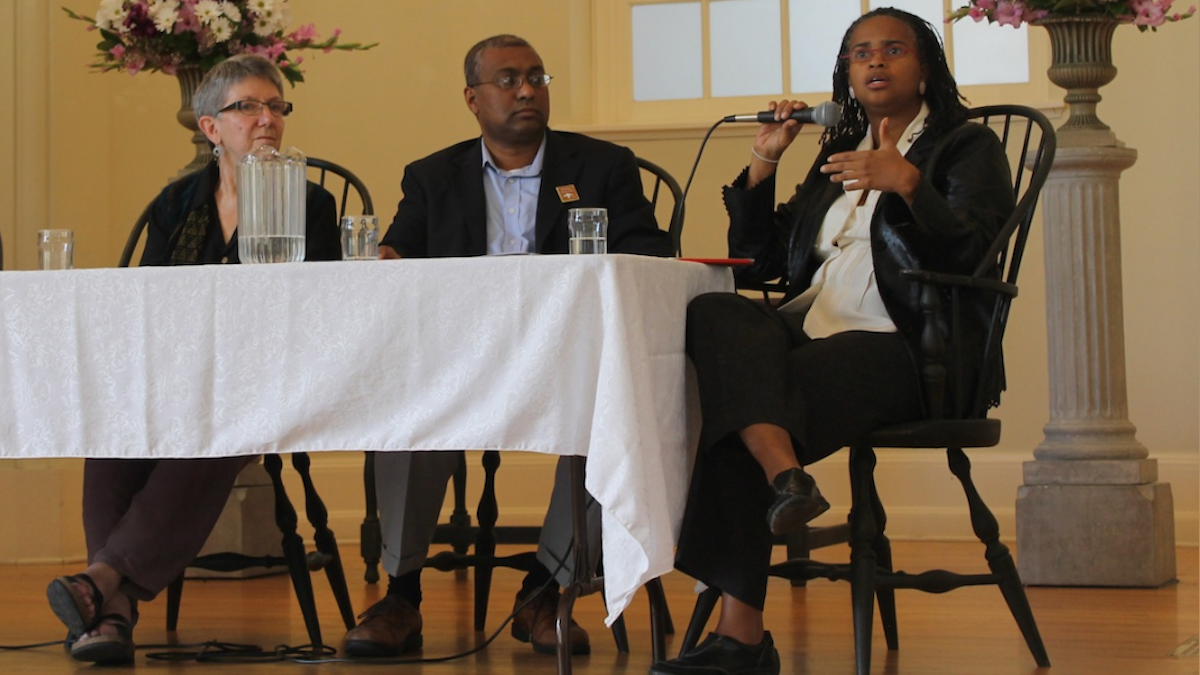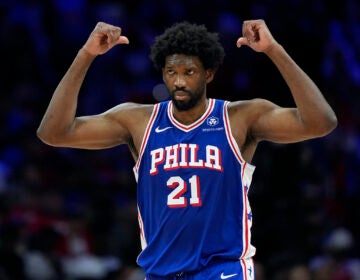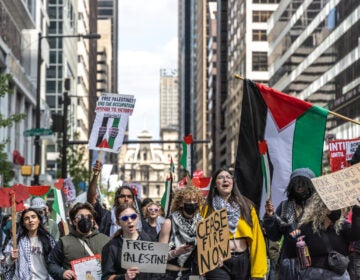Discussing gun violence through a theological lens in Northwest Philly

Rev. Leslie Callahan, seated with Iftekhar Hussain and Rabbi Linda Holtzman, examines gun violence through the lens of theology at Sunday's event in Chestnut Hill. (Matthew Grady/for NewsWorks)
With reports of mass shootings echoing in the consciousness of participants, local leaders from several faiths met on Sunday in Chestnut Hill to find common-sense solutions to curb the bloodshed.
Entitled “Gun Violence and Theology: An Interfaith Conversation,” representatives from Jewish, Catholic, Muslim and Protestant faiths examined the cause and impact of violence, along with responses to it, from both the standpoint of scripture as well as 21st-century sociopolitical realities.
The culminating event of celebrations surrounding Saturday’s Philly Peace Day, event organizers believed it to be one of few panel discussions ever held specifically addressing the connection between theology and gun violence.
Common threads
Signaling a commitment to interfaith conversation, Rev. Cynthia James of the Presbyterian Church of Chestnut Hill, which hosted the event, expressed the common desire for peace.
“All of us are headed for the hope that gun violence comes to an end,” said James.
Prompted by a question from moderator Chris Satullo, WHYY’s vice-president of News and Civic Dialogue, panelists explored the theological roots for peacemaking.
Rabbi Linda Holtzman of Mishkan Shalom in Roxborough and Iftekhar Hussain of the Council on American Islamic Relations found similarities in their faith’s respective sacred texts.
Both talked about how mankind was create in the image of God, with Holtzman observing that “there was a spark of God in each human being.”
Hussain referenced the Koran, relating that, “If anyone slays a human being, unless it be in punishment for murder or for spreading corruption, it shall be as if though they slayed all of mankind.”
Straying from scripture
Despite the principles of peace being etched in various religious documents, the panelists recognized that their faiths have been associated in history with wanton acts of violence, ranging from the Inquisition to the attacks on the World Trade Center and Pentagon.
Each panelist attributed these occurrences to human frailties.
“This is something that I have to answer every day since 9/11,” said Hussain. “It’s not my religion; it’s certain people who claim to be Muslim. Do not move that into a responsibility for the religion.”
Rev. Leslie Callahan, borrowing a phrase from the gun lobby, rearranged the notion succinctly: “Religion doesn’t kill people, people do.”
Applied to modern-day occurrences
After considering the theological and historical backdrops to conflict, panelists addressed the confluence of faith and gun violence in the context of contemporary American life.
Addressing seemingly limitless individual liberties, retired Catholic priest Fr. Jack McNamee said that this American precept would be “unthinkable” in the historical tradition of democracy, as all liberties were subordinate to the greater public good.
Embracing a practical approach to reducing violence, McNamee cautioned the audience about “Second Amendment absolutists,” and warned that stricter laws would only beget further societal ills.
Holtzman responded to a popular meme regarding gun control.
She repudiated statements maintaining that Adolf Hitler’s rise to power in Germany was accompanied by increasingly strict gun-control laws, and voiced concern about the use of violence as a political tool.
“The best defense against tyrannical government is not to get up and shoot. That feels like an absurdity,” she said, noting that some firearms proponents willfully propagate falsehoods about gun control.
From a political perspective, Callahan urged the audience to hold politicians accountable for their positions on gun control, and to look for deeper connections between political activity and financing from the gun lobby.
“We need to be less theological, and more practical,” she said.
Key to promoting peace
For Lisa Parker, organizer of Philly Peace Day, events like Sunday’s interfaith-panel discussion are important tools for reducing violence and promoting peace.
“The more that people can work together, respect their differences and find common ground, the result is less violence, discord and breakdowns between human beings,” she said.
On Saturday, Peace Day included an event entitled “American Casualties: A Drawing,” which encouraged participants to draw chalk outlines of bodies on John F. Kennedy Boulevard in memory of victims of gun violence.
The artists behind the exhibit hoped for 12,000 such outlines, representing the yearly national homicide rate.
When noting the power of imagery, Parker emphasized that Peace Day generally focuses on “positive peace-building.”
“We, as individuals, cannot end gun violence or terrorism, but we can focus on being peace-builders in our own lives, and develop compassion for the lives of others both in our city and around the globe,” she said. “By doing that in a sustained way, with Peace Day as just one entry point, we can create a more compassionate and peaceful world.”
Practical suggestions
Sunday’s speakers also put forth several ideas to help stem the tide of gun violence.
Drawing on his former ministry in disadvantaged neighborhoods, Fr. McNamee advocated for exposing at-risk populations of youths to the “Cradle to Grave” program.
A Temple University Hospital initiative, it warns against the perils of gun violence by following Lamont Adams from his birth in North Philadelphia to his death by shooting 16 years later. Students are given an explicit look into the aftermath of violence.
For her part, Callahan recommended an emphasis on mental-health strategies, which would address the trauma of being the victim of violence or living in violence-prone environments.
She referenced studies which demonstrate that children in crime-heavy neighborhoods are sometimes diagnosed with ADD but would be more accurately identified as suffering from Post-Traumatic Stress Disorder.
Callahan observed that their perceived lack of attention is actually hyper-vigilance “because they’ve seen so much.”
“There’s a public-health strategy that needs to proliferate along with the reality of gun violence,” she said.
Hussain emphasized that religious communities can be an agent for change with regard to gun violence.
“Religion is a wonderful tool to empower ourselves,” he said. “It empowers us to strive, to change this culture.”
WHYY is your source for fact-based, in-depth journalism and information. As a nonprofit organization, we rely on financial support from readers like you. Please give today.




